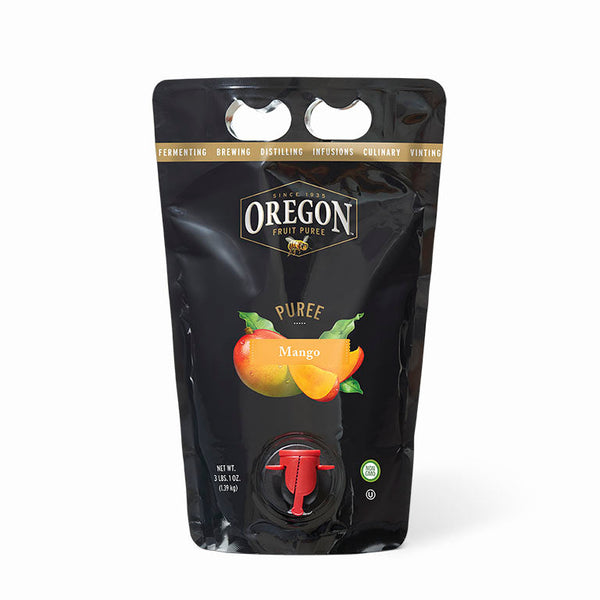To craft a Mango Beer with the all-grain method, combine fresh mango puree with a light malt base during secondary fermentation. Alter hop profiles to complement the fruit’s sweetness and tropical notes.
Mango beer merges the worlds of craft brewing and tropical fruit flavors, delivering a refreshing and aromatic beverage tailor-made for summertime sipping. This beer style has gained popularity among craft beer enthusiasts for its balance of sweetness and hop bitterness, which can be tweaked to fit the brewer’s preference.
Homebrewers and professionals often choose a clean, light malt profile as a canvas to highlight the mango’s vibrant characteristics. Using all-grain provides a more hands-on approach and can yield a more complex flavor profile, giving the brewer full control over the grain bill’s nuances. The process involves mashing grains to extract fermentable sugars, adding hops for bitterness and aroma, and carefully timing the introduction of mango to the fermentation to ensure a harmonious blend of fruit and beer.
The Allure Of Mango Beer
The fusion between juicy mangoes and aromatic hops creates an exotic twist on traditional beer. Mango beer stands out with its vibrant flavors. Enthusiasts cherish the refreshing taste that this tropical fruit brings to the brew. Homebrewers often experiment to find the perfect balance of mango sweetness and hop bitterness.
Across the brewing world, tropical beers have gained popularity. Many craft breweries now feature tropical fruit-infused options. Beer lovers enjoy these new tastes. Mango-infused beer is a sought-after choice for those who savor a touch of paradise in their pint. The appreciation for these beers grows, especially in warmer climates.
| Ingredient | Quantity | Purpose |
| Mango puree | 1 lb | Adds fruit flavor |
| Ale yeast | 1 pack | Fermentation |
| Hops | 3 oz | Bitterness & aroma |

Essential Ingredients
For the perfect mango beer, picking the right mango variety is key. Your choice affects taste and aroma. Go for sweet and aromatic types like Alphonso or Kent. These mangoes add the best tropical flair. Ensure they are ripe and juicy for maximum flavor.
Selecting the right grains is also crucial for a tropical taste. Use pilsner malt as the base for a light and crisp beer foundation. Mix with Vienna or Munich malts to introduce subtle sweetness. This combination creates the desired tropical profile in your mango beer. Balance is important, so blend your grains carefully.
Mashing For Flavor
The right mashing temperature can draw out rich flavors in your mango beer. Aim for temperatures between 148°F to 158°F for the best results.
Keeping the grain mixture at a constant temperature is key. Let it sit for about one hour. This will help you get all the sugars from your grains.
Using a thermometer will make it easy to check the heat. Keep an eye on the time too. Those sugars are important for a delicious mango beer.

The Boil: Adding Hops And Mango
Creating the perfect balance with mango beer involves careful timing. Introducing mangoes during the boil is crucial. Optimal extraction comes with adding mangoes near the end. This preserves the fruit’s natural sweetness. Ideal timings range between the last 5 to 15 minutes of the boil. Adding them too early can result in loss of aroma and can make bitterness too intense. On the other hand, late additions ensure robust mango flavors. They also contribute to a delightful sweetness that pairs well with hops.
For hops, the boil starts off by focusing on bitterness. Initial hop additions are at the start of the boil. Flavor and aroma hops go in during the last 30 and 10 minutes, respectively. This method helps achieve a beer that’s not too bitter. It also lets the hops and mangoes shine together.
Fermentation And Mango Infusion
Choosing the right yeast strain is vital for fruit beers. A popular choice is American Ale yeast, which highlights the mango flavor. For a stronger fruit presence, Belgian yeast can add complexity. Always ensure the yeast can handle higher sugar levels from the mango.
Secondary fermentation is the step to infuse mango. Clean and cube the mangoes; ensure no skin is left. After primary fermentation, transfer the beer to a secondary vessel. Then, add the mango cubes. This will impart a fresh mango taste and aroma to the beer. Let it ferment for an extra two weeks. This time allows the beer to absorb all the sweet mango flavors.
Bottling Your Tropical Creation
Knowing the perfect moment to bottle your mango beer is key for optimal carbonation. Yeast activity during fermentation produces CO2. This CO2 gives the frothy fizz to your beer. Keep an eye on your airlock to see when bubbles slow down. This slowing indicates fermentation is nearly complete. Use a hydrometer to check if your beer has reached its final gravity. Two consistent readings over two days suggest it’s time to bottle.
For those who desire extra sparkle, adding priming sugar before bottling is essential. The sugar feeds remaining yeast, creating more CO2 inside sealed bottles. Distribute the sugar evenly for consistent carbonation across all bottles. Keep bottles at room temperature for about two weeks. This wait allows carbonation to develop fully. Then, chill to enjoy your tropical brew!
Serving And Pairing
To serve your mango beer, a chilled glass is best. Pour gently to ensure a smooth, foamy head. This enhances aroma and flavor.
- Spicy dishes: Mango beer’s sweetness balances spice.
- BBQ: Complements smoky flavors.
- Seafood: Light, fruity notes pair well with ocean fare.
- Salads: A refreshing partner for greens and vinaigrettes.
- Cheese platters: Select soft cheeses like Brie or Camembert.

Frequently Asked Questions For Mango Beer Recipe All Grain
What Ingredients Are Needed For Mango Beer?
To make mango beer all grain, you’ll need base malt like 2-row or Pilsner, specialty grains for flavor, hops for bitterness and aroma, yeast for fermentation, water, and of course, ripe mangoes or mango puree for the distinct mango flavor.
How Long Does All Grain Brewing Take?
All grain brewing typically takes a full day to complete. This includes mashing, sparging, boiling, and cooling before the fermentation process begins. Additional time is needed for fermentation and conditioning, usually several weeks.
Can You Add Mango During Fermentation?
Yes, adding mango during secondary fermentation is common. This method enhances the beer’s mango flavor without risking the delicate aromas being boiled off and helps maintain better clarity in the final product.
What Is The Ideal Fermentation Temperature For Mango Beer?
The ideal fermentation temperature for mango beer is between 65 to 72 degrees Fahrenheit. This range is optimal for ale yeast strains commonly used in fruity beer styles, ensuring a clean fermentation with desired flavor profiles.
Conclusion
Embarking on the mango beer brewing journey rewards you with a unique, tropical twist on a classic beverage. This recipe simplifies the all-grain process, inviting both novice and experienced brewers to indulge in the creation of this fruity libation. Toast to your success, and savor the satisfaction of crafting a refreshing mango beer from scratch.
Cheers to your brewing adventure!

